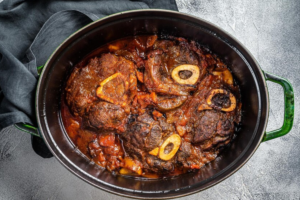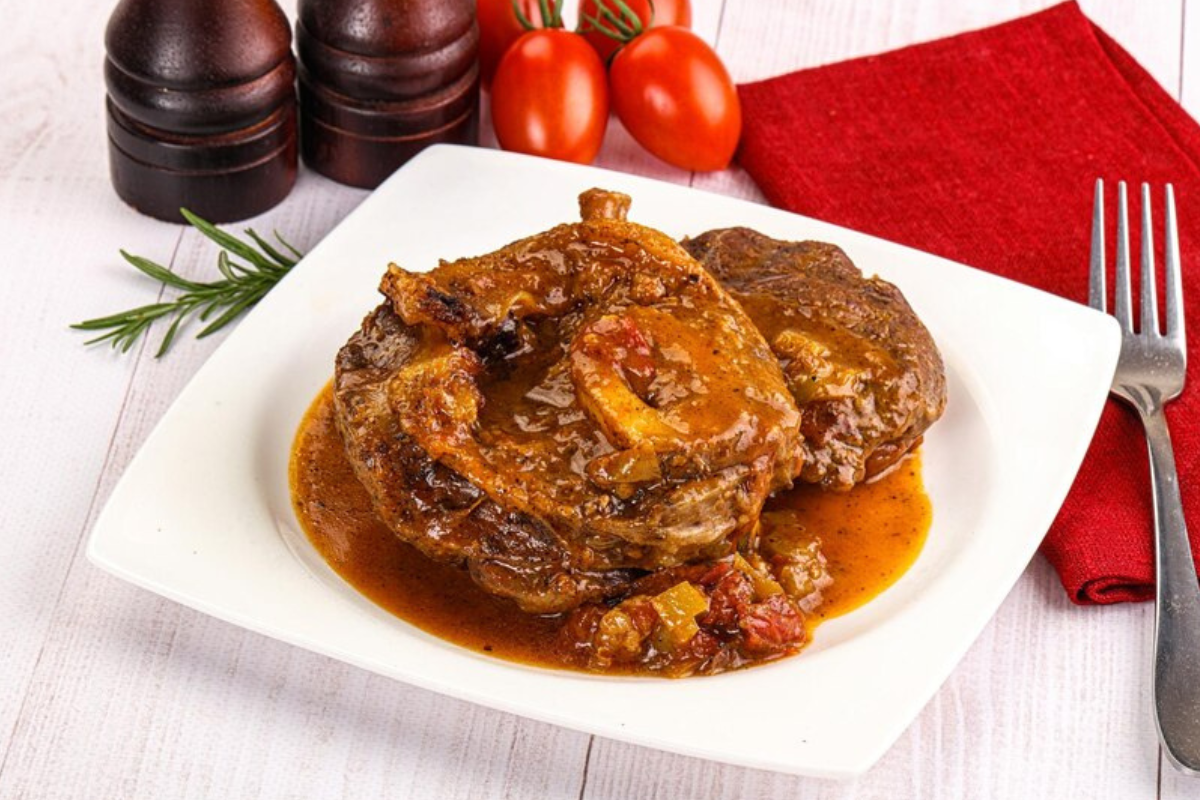When it comes to cooking succulent, fall-off-the-bone meals, beef shank recipe is one of the most underrated yet flavorful cuts. This robust cut of meat, taken from the leg of the cow, is packed with connective tissue, which makes it ideal for long, slow cooking methods like braising. In this comprehensive guide, we’ll walk you through everything you need to know about beef shank recipes, from selecting the right cut to serving it with complementary side dishes.
Whether you’re new to cooking beef shank or are looking to master some unique variations, this article will provide you with step-by-step instructions and expert tips. By the end, you’ll have the confidence to create mouth-watering dishes that are not only tender and juicy but also rich in flavor.
What is Beef Shank?
The beef shank recipe is a lean, flavorful cut from the lower part of the cow’s leg, which is used extensively for walking. As a result, the meat is naturally tough and full of muscle, but when slow-cooked, the high collagen content breaks down into a rich, gelatinous texture that’s absolutely irresistible. This makes it a popular cut for slow-cooked meals such as soups, stews, and braised dishes.
The flavor of beef shank recipe is rich and beefy, which makes it the perfect base for hearty recipes. While it requires patience and time, the end result is incredibly rewarding. Braising, stewing, and slow-cooking are the best methods to unlock its full potential, turning it into a melt-in-your-mouth delight.
Nutritional Benefits of Beef Shank
Aside from its incredible flavor, beef shank is also highly nutritious. It’s packed with high-quality protein, iron, zinc, and essential vitamins like B12. If you’re looking for a nutritious, budget-friendly cut of meat that’s perfect for long cooking times, this is it.
The bone-in variety also comes with the added benefit of bone marrow, which not only enriches the flavor of the dish but also adds important nutrients like collagen and gelatin. These nutrients are great for joint health and are known to aid in digestion.
Choosing the Right Beef Shank
When buying beef shank, you have a few options, such as bone-in and boneless cuts. The bone-in beef shank is preferred for its added flavor and nutrients, thanks to the marrow inside the bone. The boneless version is easier to serve, but it lacks the depth of flavor that the bone can provide.
When shopping for beef shank, look for:
- Freshness: The meat should be firm, with a bright red color.
- Marbling: Some fat marbling is good for flavor, but too much can make the dish greasy.
- Bone: Opt for bone-in shank for enhanced flavor and texture.
Essential Ingredients for Cooking Beef Shank
To get started, you’ll need a few key ingredients to make a basic beef shank recipe. Depending on the style you’re going for, you can adjust the ingredients and flavors, but these essentials are universal to most recipes.
Basic Ingredients:
- Beef shank: Bone-in for the best results.
- Vegetables: Carrots, onions, celery, and garlic are commonly used.
- Herbs: Fresh thyme, rosemary, and bay leaves are perfect aromatics.
- Liquids: Beef broth, red wine, or water to create a flavorful braising liquid.
- Seasonings: Salt and black pepper, with optional spices like smoked paprika or cumin.
Optional Ingredients for Added Flavor:
- Tomato paste for a richer sauce.
- Mushrooms for an earthy flavor.
- Wine (red or white, depending on the recipe) for acidity and depth.
- Soy sauce or fish sauce for an umami punch in Asian-inspired dishes.
Cooking Methods for Beef Shank: Step-by-Step Instructions

Cooking beef shank requires both patience and the right technique. Fortunately, there are several tried-and-true methods that, when followed carefully, will ensure your meat turns out tender and flavorful every time.
Braising: The Best Method for Tender Beef Shank
Braising is, by far, the best method for cooking beef shank. It’s a slow-cooking process that involves searing the meat first, then simmering it in a flavorful liquid until it becomes tender.
Step-by-Step Braising Method:
- Sear the Beef Shank: Heat some oil in a heavy-bottomed pan (like a Dutch oven) and sear the beef shank on all sides until it’s browned. This step is essential for building flavor.
- Sauté Vegetables: Once the meat is browned, remove it from the pan and sauté onions, garlic, carrots, and celery until they soften.
- Deglaze the Pan: Add some broth or wine to the pan, scraping up the browned bits stuck to the bottom. This will add tons of flavor to your dish.
- Add the Shank and Liquids: Return the beef shank to the pot and pour in enough broth to cover about two-thirds of the meat. Add herbs and seasonings at this point.
- Braise Slowly: Cover the pot and place it in a preheated oven at 300°F. Let it cook for 3 to 4 hours, or until the meat is fork-tender.
This method will give you a tender, flavorful beef shank that pairs well with just about anything—from creamy mashed potatoes to hearty polenta.
Slow-Cooker Beef Shank: The Easy Method
For a more hands-off approach, the slow cooker works wonders for beef shank. Simply throw all your ingredients into the cooker, set it on low, and let it work its magic for 6 to 8 hours. This method is ideal for busy days when you want a delicious meal without much effort.
Slow-Cooker Recipe Tips:
- Layer flavors: Sear the meat and sauté the vegetables before adding them to the slow cooker to maximize flavor.
- Cook low and slow: The low setting allows the collagen in the meat to break down properly, resulting in tender meat.
- Liquid ratio: Make sure to use enough liquid (broth, wine, or water) to partially submerge the meat but not drown it.
Instant Pot Beef Shank: Speed Without Sacrificing Flavor
If you don’t have time for long braises or slow-cooking, fortunately, an Instant Pot or pressure cooker can save the day. With this method, you’ll still get that melt-in-your-mouth texture in just about an hour.
Instant Pot Instructions:
- Sear the meat in the Instant Pot on the sauté function.
- Add the aromatics and liquids, just as you would for a braise or slow-cook.
- Cook on high pressure for about 45 minutes, followed by a natural pressure release to let the juices settle.
Popular Beef Shank Recipe Variations
1. Classic Osso Buco: The Italian Favorite
Osso Buco is a traditional Italian dish made with braised beef shank (or veal shank) that’s slow-cooked in combination with white wine, broth, and aromatics. Furthermore, it’s typically served with a gremolata topping, which is a mixture of lemon zest, garlic, and parsley, and it is often paired with risotto or polenta for a complete meal.
Osso Buco Recipe:
- Ingredients: Beef shanks, carrots, onions, garlic, celery, white wine, beef broth, lemon, parsley, and garlic.
- Instructions: Sear the beef shanks, sauté the vegetables, deglaze with white wine, and braise in the oven at 325°F for 2 to 3 hours. Top with gremolata before serving.
2. Asian-Style Braised Beef Shank
For a different take, you can try a soy sauce-based braise with Asian spices such as star anise, ginger, and cinnamon. Consequently, this version offers a rich, umami-packed flavor that’s ideal for pairing with rice or noodles.
Asian Beef Shank Recipe:
- Ingredients: Beef shanks, soy sauce, beef broth, star anise, ginger, garlic, cinnamon sticks.
- Instructions: Sear the beef, sauté the aromatics, and braise in the oven with soy sauce and broth for 3 hours.
Perfect Pairings: Side Dishes for Beef Shank
No beef shank recipe is complete without some delicious sides to soak up the rich sauce. Here are some top options:
- Mashed potatoes: Creamy mashed potatoes are a perfect pairing, absorbing the flavorful juices.
- Polenta: A smooth polenta works well, especially for Italian-inspired beef shank dishes like Osso Buco.
- Roasted root vegetables: Roasted carrots, parsnips, and turnips add a sweet contrast to the rich meat.
- Crusty bread: A thick slice of rustic bread is ideal for sopping up every last drop of sauce.
For more ideas, check out this recipe for cheesy potatoes, which makes a delightful side for a comforting beef dish.
Expert Tips for Cooking Beef Shank
1. Opt for Bone-In Shank
Whenever possible, choose a bone-in beef shank. The bone adds extra flavor and depth to the dish, and the marrow can enhance the sauce with richness.
2. Slow and Low is Key
The trick to cooking beef shank is time and patience. Cooking it too quickly will result in tough, chewy meat. Whether braising or slow-cooking, always opt for low heat and long cooking times.
3. Don’t Skimp on Searing
Searing your meat before cooking is absolutely crucial for developing deep flavors, as the Maillard reaction that occurs during browning further adds complexity to the final dish.
4. Use the Right Liquids
However, the type of liquid you choose will significantly influence the final flavor of the dish. For instance, wine not only adds acidity but also brings depth to the overall taste, whereas broth, on the other hand, enhances the meatiness of the dish.
FAQs
What’s the Best Way to Cook Beef Shank?
Braising is undoubtedly the gold standard for cooking beef shank because the slow, moist heat effectively tenderizes the tough meat, gradually transforming it into a succulent, flavorful dish.
Can Beef Shank Be Overcooked?
Yes, overcooking beef shank recipe can dry it out, especially if you cook it at too high a temperature or for too long. Stick to low heat and monitor cooking time to ensure tenderness without drying out the meat.
What’s the Difference Between Beef Shank and Osso Buco?
Beef shank refers to the cut of meat, while Osso Buco is an Italian dish that uses beef or veal shank, slow-cooks it with vegetables, wine, and broth, and typically serves it with gremolata and risotto.
How Should I Store Leftover Beef Shank?
Store leftover beef shank in an airtight container in the fridge for up to 3 days. To reheat, warm it slowly on the stovetop or in the oven. You can also freeze leftovers for up to 3 months.
Conclusion:
If you’re looking to create rich, hearty meals that impress, beef shank recipe should be at the top of your list. From Osso Buco to red wine-braised beef shank, there’s a wide variety of recipes to explore, each offering a unique twist on this flavorful cut of meat.
With the right cooking techniques, you can transform this tough cut into a melt-in-your-mouth masterpiece. Whether you braise, slow-cook, or pressure-cook, you will experience an explosion of flavors and create a dish that’s sure to impress.
Try these recipes today and savor the rich, beefy goodness of perfectly cooked beef shank. Enjoy!

